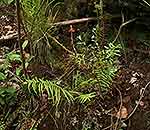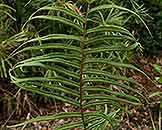Pteris vittata L.
Synonyms |
Pteris diversifolia Sw. |
|---|---|
Common name |
|
Description |
Rhizome prostrate to suberect, short, up to 8 mm in diameter; rhizome scales linear to lanceolate with a long hair-tip, pale brown, up to 7 mm long, entire. Fronds tufted or closely spaced, arching, herbaceous to slightly coriaceous, 0.75-1.8 m tall. Stipe up to 20 cm long but varying in length, pale brown, glabrous with age and with scales similar to the rhizome near the base. Lamina up to 1.15 × 0.4 m, oblong-lanceolate in outline, pinnate, middle pinnae the longest and basal pinnae gradually reducing in size. Pinnae in 20-40 pairs, 2-22 x 0.7-1.4 cm, opposite to alternate, shortly stalked, linear to narrowly lanceolate in outline, apex gradually tapering to a point, base cordate or rounded, margins minutely toothed; veins free; glabrous on both surfaces; costae prominent below. Rhachis glabrous or slightly scaly, pale brown. Sori linear, continuous, submarginal; indusia entire, membranous. |
Notes | P. vittata is pinnate, unlike the other species of Pteris. |
Derivation | vitta: narrow headband worn during sacrificial rites; alluding to the narrow linear pinnae. |
Habitat | Rock crevices, coral rag, river banks, wet evergreen forest, walls and roadsides, permanantly wet places in arid regions. |
Distribution worldwide | Widespread in Africa, also Arabia, Cape Verde Isl., Canary Isl., Comoro & Mascarene Isl., Madagascar, Socotra, tropical Asia, China, Japan, Malaysia, Papua New Guinea, Australia and Polynesia, also Spain, Yemen. |
Distribution in Africa |
Algeria, Angola, Botswana, Burundi, Cameroon, Dem. Republic of Congo, Djibouti, Ethiopia, Ghana, Kenya, Lesotho, Libya, Malawi, Morocco and Western Sahara, Mozambique, Namibia, Rwanda, Somalia, South Africa, Sudan and South Sudan, Swaziland, Tanzania , Tunesia, Uganda, Zambia, Zimbabwe. |
Growth form |
Lithophytic, terrestrial. |
Literature |
|




